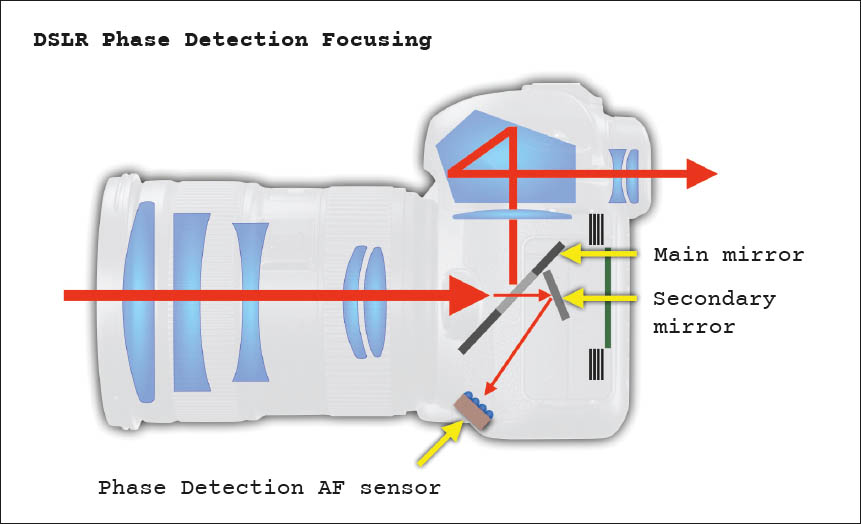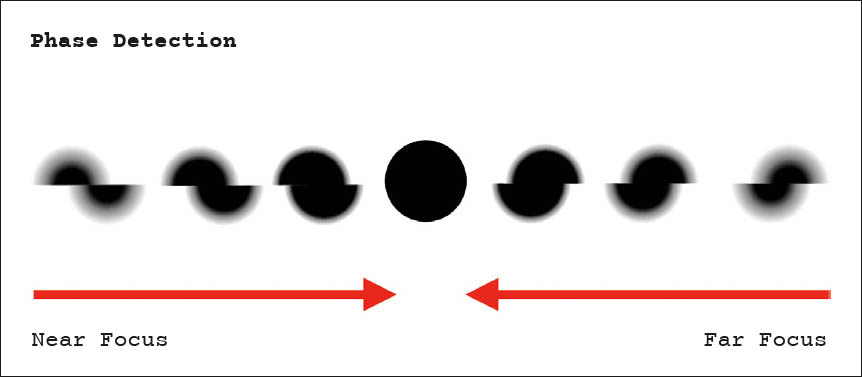12. PHASE DETECTION
![]()
DSLR CAMERAS USE a phase detection sensor as their primary focusing system. This system uses a beam splitter to compare two rays of light from different parts of the lens. Phase detection focusing has been the standard for SLR-style cameras since the mid-1980s, and has the principal benefit of being very fast in operation (Figure 12.1).
When light enters a DSLR, the light is reflected off a mirror and up to a prism system so the photographer can see what the camera is pointed at. The primary mirror has a translucent section in the middle that allows a small amount of light to pass directly through it. The light that passes through the primary mirror bounces off a secondary mirror. The light splits in two and is directed to a phase detection autofocus sensor for analysis. The two images (created by the two beams of light) are analyzed to reveal the state of focus. Depending on how they compare, the camera can tell how in or out of focus the image will be (Figure 12.2).
A huge benefit of this system is that as soon as light enters the camera, the AF sensor can determine if the subject is in or out of focus, which direction the lens needs to be moved to achieve focus and how much adjustment is necessary.
Because this system is measuring the light at a location away from the image sensor, it is possible for the measurement to be in error. In theory there shouldn’t be any error, but minor manufacturing variances can result in slight errors that can lead to missed focus. If the lens focuses in front of the subject, it’s called front focusing; if the lens focuses behind the subject, it’s called back focusing. If this is a consistent problem with your autofocus, there might be an error in the system. In the past, all cameras and lenses would have to be sent to a repair facility to remedy this problem. Some higher-end DSLRs now offer an adjustment option called Autofocus Calibration (section 17). No matter what type of DSLR you have, take note of out-of-focus images to see if their errors are consistent. If so, there is a way to correct for them.
One of the benefits of the phase detection system is that measurement readings can be taken each time the mirror returns to its lowered position, even in a continuous shooting mode. While it may only have a fraction of a second to read the light, it’s enough time for the focusing system to follow the action. The top DSLRs will do this at ten or more frames per second. To increase the tracking ability, some higher-end systems have implemented higher-resolution sensors capable of recognizing colors and faces.
The phase detection system works well for subjects with high contrast—lines, in particular. Depending on the sensor and the point of focus that is being measured, the system may be more sensitive to vertical lines, horizontal lines, or both. It’s advisable to find strong lines to focus on. Achieving autofocus is also dependent on light, and the system will perform poorly in very dark situations. This is the reason some cameras or flash units have AF illumination lights that will turn on if the light level is too low for the AF system to achieve focus.
12.1 The phase detection system in a DSLR uses a phase detection AF sensor that receives light only when the primary and secondary mirror are both in their lowered position.
12.2 The phase detection system is quick because it can instantly determine if a subject is near- or far-focused, and how much and in which direction it should adjust the focus of the lens.


